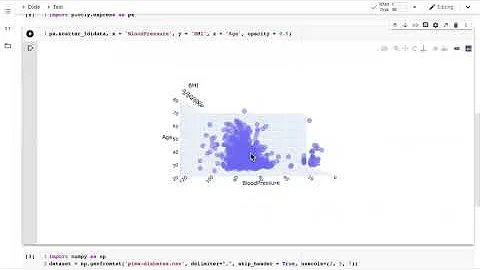Multiple Linear Regression Model by using Tensorflow
The feature normalization should be done by subtracting mean and dividing by range (or standard deviation).
def feature_normalize(train_X):
global mean, std
mean = np.mean(train_X, axis=0)
std = np.std(train_X, axis=0)
return (train_X - mean) / std
Do not forget to normalize your features when you make this prediction.
predict_X = (predict_X - mean)/std
Related videos on Youtube
Elsa Lin
Updated on June 04, 2022Comments
-
 Elsa Lin almost 2 years
Elsa Lin almost 2 yearsI want to build a multiple linear regression model by using Tensorflow.
Dataset: Portland housing prices
One data example: 2104,3,399900 (The first two are features, and the last one is house price; we have 47 examples)
Code below:
import numpy as np import tensorflow as tf import matplotlib.pyplot as plt # model parameters as external flags flags = tf.app.flags FLAGS = flags.FLAGS flags.DEFINE_float('learning_rate', 1.0, 'Initial learning rate.') flags.DEFINE_integer('max_steps', 100, 'Number of steps to run trainer.') flags.DEFINE_integer('display_step', 100, 'Display logs per step.') def run_training(train_X, train_Y): X = tf.placeholder(tf.float32, [m, n]) Y = tf.placeholder(tf.float32, [m, 1]) # weights W = tf.Variable(tf.zeros([n, 1], dtype=np.float32), name="weight") b = tf.Variable(tf.zeros([1], dtype=np.float32), name="bias") # linear model activation = tf.add(tf.matmul(X, W), b) cost = tf.reduce_sum(tf.square(activation - Y)) / (2*m) optimizer = tf.train.GradientDescentOptimizer(FLAGS.learning_rate).minimize(cost) with tf.Session() as sess: init = tf.initialize_all_variables() sess.run(init) for step in range(FLAGS.max_steps): sess.run(optimizer, feed_dict={X: np.asarray(train_X), Y: np.asarray(train_Y)}) if step % FLAGS.display_step == 0: print "Step:", "%04d" % (step+1), "Cost=", "{:.2f}".format(sess.run(cost, \ feed_dict={X: np.asarray(train_X), Y: np.asarray(train_Y)})), "W=", sess.run(W), "b=", sess.run(b) print "Optimization Finished!" training_cost = sess.run(cost, feed_dict={X: np.asarray(train_X), Y: np.asarray(train_Y)}) print "Training Cost=", training_cost, "W=", sess.run(W), "b=", sess.run(b), '\n' print "Predict.... (Predict a house with 1650 square feet and 3 bedrooms.)" predict_X = np.array([1650, 3], dtype=np.float32).reshape((1, 2)) # Do not forget to normalize your features when you make this prediction predict_X = predict_X / np.linalg.norm(predict_X) predict_Y = tf.add(tf.matmul(predict_X, W),b) print "House price(Y) =", sess.run(predict_Y) def read_data(filename, read_from_file = True): global m, n if read_from_file: with open(filename) as fd: data_list = fd.read().splitlines() m = len(data_list) # number of examples n = 2 # number of features train_X = np.zeros([m, n], dtype=np.float32) train_Y = np.zeros([m, 1], dtype=np.float32) for i in range(m): datas = data_list[i].split(",") for j in range(n): train_X[i][j] = float(datas[j]) train_Y[i][0] = float(datas[-1]) else: m = 47 n = 2 train_X = np.array( [[ 2.10400000e+03, 3.00000000e+00], [ 1.60000000e+03, 3.00000000e+00], [ 2.40000000e+03, 3.00000000e+00], [ 1.41600000e+03, 2.00000000e+00], [ 3.00000000e+03, 4.00000000e+00], [ 1.98500000e+03, 4.00000000e+00], [ 1.53400000e+03, 3.00000000e+00], [ 1.42700000e+03, 3.00000000e+00], [ 1.38000000e+03, 3.00000000e+00], [ 1.49400000e+03, 3.00000000e+00], [ 1.94000000e+03, 4.00000000e+00], [ 2.00000000e+03, 3.00000000e+00], [ 1.89000000e+03, 3.00000000e+00], [ 4.47800000e+03, 5.00000000e+00], [ 1.26800000e+03, 3.00000000e+00], [ 2.30000000e+03, 4.00000000e+00], [ 1.32000000e+03, 2.00000000e+00], [ 1.23600000e+03, 3.00000000e+00], [ 2.60900000e+03, 4.00000000e+00], [ 3.03100000e+03, 4.00000000e+00], [ 1.76700000e+03, 3.00000000e+00], [ 1.88800000e+03, 2.00000000e+00], [ 1.60400000e+03, 3.00000000e+00], [ 1.96200000e+03, 4.00000000e+00], [ 3.89000000e+03, 3.00000000e+00], [ 1.10000000e+03, 3.00000000e+00], [ 1.45800000e+03, 3.00000000e+00], [ 2.52600000e+03, 3.00000000e+00], [ 2.20000000e+03, 3.00000000e+00], [ 2.63700000e+03, 3.00000000e+00], [ 1.83900000e+03, 2.00000000e+00], [ 1.00000000e+03, 1.00000000e+00], [ 2.04000000e+03, 4.00000000e+00], [ 3.13700000e+03, 3.00000000e+00], [ 1.81100000e+03, 4.00000000e+00], [ 1.43700000e+03, 3.00000000e+00], [ 1.23900000e+03, 3.00000000e+00], [ 2.13200000e+03, 4.00000000e+00], [ 4.21500000e+03, 4.00000000e+00], [ 2.16200000e+03, 4.00000000e+00], [ 1.66400000e+03, 2.00000000e+00], [ 2.23800000e+03, 3.00000000e+00], [ 2.56700000e+03, 4.00000000e+00], [ 1.20000000e+03, 3.00000000e+00], [ 8.52000000e+02, 2.00000000e+00], [ 1.85200000e+03, 4.00000000e+00], [ 1.20300000e+03, 3.00000000e+00]] ).astype('float32') train_Y = np.array([[ 399900.], [ 329900.], [ 369000.], [ 232000.], [ 539900.], [ 299900.], [ 314900.], [ 198999.], [ 212000.], [ 242500.], [ 239999.], [ 347000.], [ 329999.], [ 699900.], [ 259900.], [ 449900.], [ 299900.], [ 199900.], [ 499998.], [ 599000.], [ 252900.], [ 255000.], [ 242900.], [ 259900.], [ 573900.], [ 249900.], [ 464500.], [ 469000.], [ 475000.], [ 299900.], [ 349900.], [ 169900.], [ 314900.], [ 579900.], [ 285900.], [ 249900.], [ 229900.], [ 345000.], [ 549000.], [ 287000.], [ 368500.], [ 329900.], [ 314000.], [ 299000.], [ 179900.], [ 299900.], [ 239500.]] ).astype('float32') return train_X, train_Y def feature_normalize(train_X): train_X_tmp = train_X.transpose() for N in range(2): train_X_tmp[N] = train_X_tmp[N] / np.linalg.norm(train_X_tmp[N]) train_X = train_X_tmp.transpose() return train_X import sys def main(argv): if not argv: print "Enter data filename." sys.exit() filename = argv[1] train_X, train_Y = read_data(filename, False) train_X = feature_normalize(train_X) run_training(train_X, train_Y) if __name__ == '__main__': tf.app.run()Results I got:
with learning rate 1.0 and 100 iterations, the model finally predicts a house with 1650 square feet and 3 bedrooms get a price $752,903, with:
Training Cost= 4.94429e+09
W= [[ 505305.375] [ 177712.625]]
b= [ 247275.515625]
There must be some mistakes in my code as the plot of the cost function for different learning rates is just not same with the solution
I should got the following results as solution suggested:
theta_0: 340,413
theta_1: 110,631
theta_2: -6,649
The predicted price of the house should be $293,081.
Any wrong with my usage of tensorflow?
-
user2717954 almost 8 yearswhy tensorflow? this is such an overkill for your case (ignoring many other mistakes like using GD to solve linear regression problem etc)
-
 Elsa Lin almost 8 years@user2717954 just want to get familiar with tensorflow.. is it inappropriate to use Gradient Descent solving this problem?
Elsa Lin almost 8 years@user2717954 just want to get familiar with tensorflow.. is it inappropriate to use Gradient Descent solving this problem? -
user2717954 almost 8 yearslinear regression has a closed form solution (least squares, wiki it up). also, if you want to use GD for some reason, I'd suggest a much smaller learning rate to begin with (try 0.01 and see if your results are any better)
-
 Elsa Lin almost 8 yearsI tried values of the learning rate(Optimized training cost): 1.0(2.06816e+09), 0.3(2.309e+09), 0.1(3.68169e+09), 0.03(5.7212e+09), 0.01(6.71778e+09), with 2000 iterations and plot at every 100 steps. The best training cost I got is with learning rate 1.0. The plots look like: 1.0, 0.3, 0.1, 0.03, 0.01
Elsa Lin almost 8 yearsI tried values of the learning rate(Optimized training cost): 1.0(2.06816e+09), 0.3(2.309e+09), 0.1(3.68169e+09), 0.03(5.7212e+09), 0.01(6.71778e+09), with 2000 iterations and plot at every 100 steps. The best training cost I got is with learning rate 1.0. The plots look like: 1.0, 0.3, 0.1, 0.03, 0.01 -
 Elsa Lin almost 8 yearsI'm just not sure where my mistakes are.
Elsa Lin almost 8 yearsI'm just not sure where my mistakes are. -
user2717954 almost 8 yearswhy do you normalize your features this way?
-
 Elsa Lin almost 8 yearsI fixed the feature normalization by subtracting the mean and dividing by standard deviation, with learning rate 1.0 and 100 iterations, I wound up getting the same result as the solution suggested. Thanks!
Elsa Lin almost 8 yearsI fixed the feature normalization by subtracting the mean and dividing by standard deviation, with learning rate 1.0 and 100 iterations, I wound up getting the same result as the solution suggested. Thanks! -
 Elsa Lin almost 8 yearsRevised the code below.
Elsa Lin almost 8 yearsRevised the code below.
-
-
user1877600 over 7 yearsI suppose, you reinvent the wheel. Sklearn contains object responsible for such transformations scikit-learn.org/stable/modules/generated/…
-
 bad_coder about 4 yearsWelcome to stackoverflow. Can you please include a brief explanation of the code and how it solves the problem in the question?
bad_coder about 4 yearsWelcome to stackoverflow. Can you please include a brief explanation of the code and how it solves the problem in the question?




